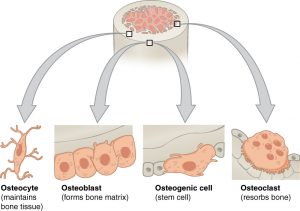Bone Biology Review: What Does New Research Show?

There is considerable scientific knowledge about the causes, prevention, and treatment of bone disorders, but many gaps remain in this information. For example, it is not clearly understood why fractures occur in so many people. In this bone biology review, we look at some of the recent discoveries in skeletal genetics and metabolism that are expected to improve our understanding of bone health.
We offer online continuing education for radiologic technologists. To browse through our range of CE courses that are recognized category-A ARRT® CE credits, visit our X-ray Continuing Education page.
RANK Ligand and Osteoprotegerin
There have been recent discoveries about the communication between osteoblasts and osteoclasts and the cell signals that lead to the initiation of bone resorption. It is now known that osteoblasts stimulate the proliferation and differentiation of osteoclasts and increase their activity by producing macrophage colony stimulating factors and RANK ligand proteins which bind to osteoclast precursors. Osteoblasts also produce osteoprotegerin, a protein which prevents the interaction between RANK ligand and osteoclasts. This system is regulated by local factors as well as systemic hormones that stimulate bone resorption.
Bone biology review shows that the rate of bone breakdown is determined by the critical balance between RANK ligand (RANKL) and osteoprotegerin (OPG). However, we do not yet have a precise understanding of the interaction between these two proteins. In people with estrogen deficiency, RANKL is increased in the bones. However, the theory that excessive RANKL or deficient OPG will lead to bone loss is not supported by the circulating levels of these proteins in blood. It has been noted that in patients with low bone mass and fractures, RANKL levels are in fact low and OPG levels are in fact high, contrary to what one would expect. Nonetheless, drugs that simulate OPG and interfere with the binding of RANKL to osteoclasts are a useful therapeutic approach for the treatment of osteoporosis.
Osteoblasts and Osteoclasts
In this section of the bone biology review, let’s take a look at the interaction between osteoblast and osteoclast precursors. Cells of osteoblastic lineage produce different proteins that regulate osteoclast formation and function. The macrophage colony stimulating factor increases the number of osteoclast precursors. Another protein called RANK ligand binds to receptors on osteoclast precursors and stimulates them to differentiate from quiescent precursors to active osteoclasts.
New research and bone biology review shows that the interaction between the RANK ligand protein and its receptor on the surface of the osteoclast precursor cells also increases the activity of the osteoclasts. Finally, cells of osteoblastic lineage produce osteoprotegerin, a protein that can bind to the RANK ligand and prevent it from interacting with the RANK receptor on the osteoclasts, thereby preventing osteoclast formation and activation. Local factors and systemic hormones such as parathyroid hormone, calcitriol, interleukin-1, and prostaglandin E2 act on osteoblasts to increase RANKL production and decrease OPG production. The fine balance between RANKL and OPG determines the rate of bone breakdown.
LDL-Receptor-Related Protein 5
Another recently discovered receptor in the bone signaling system is the LDL-receptor-related protein 5. People in whom this receptor is overactive have strong bones and are protected against fractures. Conversely, people in whom this receptor is dysfunctional develop severe osteoporosis. Bone biology review indicates that smaller mutations in the gene for this receptor can affect the size and strength of bones and the stature of the individual.
Chromosome 20P12.3
Other genes that influence bone mass and bone strength have also been identified. In mice models, the gene that codes for the enzyme lipoxygenase was found to have an effect on bone mass. A link between osteoporosis and chromosome 20p12.3 has been identified by genetic studies conducted in Iceland, confirming that there is a significant genetic component to the condition. However, many genes and specific chromosomal sites that regulate bone architecture and bone mass remain unidentified on bone biology review.
Bone Biology Review of Latest Findings
These new findings could ultimately improve our understanding of bone disease and our ability to assess an individual’s risk of developing osteoporosis or other skeletal problems. Nonetheless, we have enough knowledge currently available about what causes bone diseases, how we can prevent them, and how we can diagnose and treat them in a timely manner. Both personal health measures and public health approaches are needed to apply this knowledge to decrease fracture risk and improve the overall bone health of Americans.
Bone Biology Directions for Future Research
The remarkable progress in our understanding of bone biology review at a cellular and molecular level and our knowledge of the genetics of the skeletal system has answered many key questions. It has also raised a number of new questions. Researchers are now trying to answer these additional questions. It is expected that this will lead to further progress and newer approaches to the prevention, diagnosis, and treatment of bone disorders.
Some of the questions that researchers are attempting to answer include how the normal skeleton copes with mechanical forces and maintains its structure, why this response is lost in individuals with bone disease, the specific role of local factors that influence this process, and the individual steps in bone remodeling, particularly the reversal phase.
The precise role of estrogen in maintaining bone mass is also of interest to scientists studying bone biology review. This is because of its relative importance to other systemic hormones and the role they play in bone health. Newer hormones such as leptin and newer proteins and genes such as the Wnt signal pathway are being studied to understand their effect on bones.
X-ray Continuing Education
Please purchase our bone densitometry course for an indepth review of bone biology, diseases, and of course, imaging. This course is worth 23 ARRT® recognized CEUs. We also have other e-courses on a range of topics and worth between 1 and 24 X-ray CE credits.
Here is details about radiology ce credits online